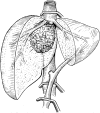Combined resection of the liver and inferior vena cava for hepatic malignancy
- PMID: 15082976
- PMCID: PMC1356280
- DOI: 10.1097/01.sla.0000124387.87757.eb
Combined resection of the liver and inferior vena cava for hepatic malignancy
Abstract
Objective: The objective of this paper is to review the results of combined resection of the liver and inferior vena cava for hepatic malignancy. The morbidity and mortality along with preliminary survival data are assessed in order to determine the utility of this aggressive approach to otherwise unresectable tumors.
Summary background data: Involvement of the inferior vena cava has traditionally been considered a contraindication to resection for advanced tumors of the liver because the surgical risks are high and the long-term prognosis is poor. Progress in liver surgery allows resection in some cases.
Methods: Twenty-two patients undergoing hepatic resection from 1997 to 2003, that also required resection and reconstruction of the inferior vena cava (IVC), were reviewed. The median age was 49 years (range 2 to 68 years). Resections were carried out for: hepatocellular carcinoma (n = 6), colorectal metastases (n = 6), cholangiocarcinoma (n = 5), gastrointestinal stromal tumor (n = 2), hepatoblastoma (n = 2), and squamous cell carcinoma in 1 patient. Liver resections performed included 13 right trisegmentectomies, 6 right lobectomies extended to include the caudate lobe, and 3 left trisegmentectomies. Complex ex vivo procedures were performed in 2 cases using venovenous bypass while the other 20 cases were performed using varying degrees of vascular isolation. In situ cold perfusion of the liver was used in 1 case. The IVC was reconstructed with ringed Gore-Tex tube graft (n = 14), primarily (n = 6), or with Gore-Tex patches (n = 2).
Results: There were 2 perioperative deaths (9%). One cirrhotic patient died of liver failure 3 weeks post operatively and 1 patient with cholangiocarcinoma died of pulmonary hemorrhage secondary to a cavitating pulmonary infection after aspiration pneumonia 6 weeks after resection. Six patients had evidence of postoperative liver failure that resolved with supportive management and 2 patients required temporary dialysis. All vascular reconstructions were patent at last follow-up. With median follow-up of 26 months, 5 patients have died of recurrent malignancy at 44, 40, 32, 26, and 24 months, while an additional patient is alive with disease at 31 months. Actuarial 1-, 3-, and 5-year survivals were 85%, 60%, and 33%, respectively.
Conclusions: IVC involvement by hepatic malignancy does not necessarily preclude resection. Liver resection with reconstruction of the inferior vena cava can be performed in selected cases. The increased risk associated with the procedure appears to be balanced by the possible benefits, particularly when the lack of alternative curative approaches is considered.
Figures






References
-
- Philosophe B, Greig PD, Hemming AW, et al. Surgical management of hepatocellular carcinoma: resection or transplantation? J Gastrointest Surg. 1998;2:21–27. - PubMed
-
- Hemming AW, Sielaff TD, Gallinger S, et al. Hepatic resection of noncolorectal nonneuroendocrine metastases. Liver Transpl. 2000;6:97–101. - PubMed
-
- Belghiti J, Hiramatsu K, Benoist S, et al. Seven hundred forty-seven hepatectomies in the 1990s: an update to evaluate the actual risk of liver resection. J Am Coll Surg. 2000;191:38–46. - PubMed
MeSH terms
LinkOut - more resources
Full Text Sources
Medical

